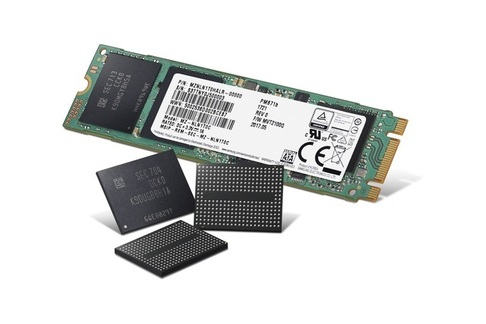 |
|
Samsung Electronics’ V-NAND flash chip (provided by Samsung Electronics)
|
Analysts suggest anti-trust probe is part of China’s stalling tactic in trade war with US
The Chinese government effectively launched an investigation into alleged price-fixing by the world’s top three memory semiconductor makers: Samsung Electronics, SK Hynix, and the US company Micron. Analysts said that in addition to its aim of driving the price of memory down, the move may also be part of China’s trade war against the US and a stalling tactic buying time for China to foster its own semiconductor industry. China’s 21st Century Economic Report and Hong Kong’s Ming Pao recently reported that antitrust investigators with China’s State Administration for Market Supervision visited Samsung Electronics, SK Hynix, and Micron’s offices in Beijing, Shanghai, and Shenzhen on May 31 for an antitrust investigation. While nothing has yet been announced by the Chinese government, industry observers saw the move as the de facto launch of a memory semiconductor price-fixing investigation. Since early this year, the Chinese government has summoned officials from Samsung Electronics’ Chinese branch and others to demand that they “refrain from raising memory semiconductor prices.” China accounts for 35 percent of Samsung Electronics’ DRAM sales and 40.7 percent of SK Hynix’s. Analysts said China’s reasons for launching a price-fixing investigation on memory are threefold. First, they suggested it is intended as pressure to drive down prices. A sharp rise in memory prices over the past two years has resulted in serious complaints from Chinese IT device manufacturers, who rely on imports for most of their memory semiconductors. The companies that dominate the memory market – including Samsung Electronics, Hynix, and Micron – have operating profit ratios in the range of 40–50 percent for the sector, while Chinese IT device manufacturers have ratios in the 10-percent range. “Chinese smartphone companies like Huawei, Xiaomi, Oppo, and Vivo rank in the third to sixth range for market share, but they’re barely making a profit,” an industry source explained. “Their complaint is that DRAM and NAND flash prices are too high,” the source said. Analysts also said the move was intended to keep overseas companies in check while China works on fostering its own semiconductor industry. In 2016, China announced plans to usher its semiconductor industry forward with 1 trillion yuan (US$156 billion) in investment over 10 years. With plans to begin a pilot memory semiconductor production effort in the second half of this year and full-scale mass production next year, analysts suggested it is now pressuring Samsung Electronics and SK Hynix in order to buy time. Observers also interpreted the move as a response measure in China’s trade war with the US. With the Chinese IT corporation ZTE facing looming bankruptcy after US penalties, analysts suggested the de facto investigation may be a form of retaliation. Industry observers predicted China’s price-fixing investigation is unlikely to have immediate effects on the companies in question. With the semiconductor boom rooted in cloud servers and other areas of robust demand, the high price trend is expected to continue. “Samsung and Hynix have consistently been running their factories at 100 percent and investing trillions of won each year in additional production,” an industry source said. “Claims that they are adjusting supplies to fix prices are not accurate,” the source added. But some have expressed concerns that Beijing will not back down meekly from its price-fixing investigation. By Choi Hyun-june, staff reporter Please direct comments or questions to [english@hani.co.kr]






